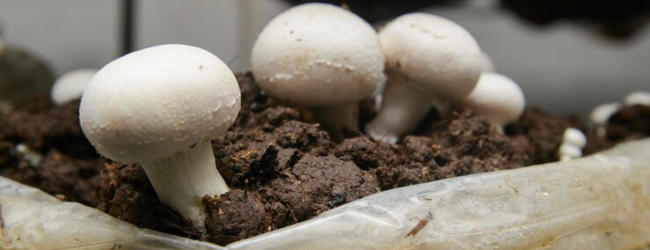Table of contents
- What is Button Mushroom Farming?
- Why Choose Button Mushroom Farming in India?
- Where is Button Mushroom Farming Popular in India?
- Step-by-Step Process of Button Mushroom Farming
- Profitability of Button Mushroom Farming
- Marketing & Sales Channels
- Real Success Story
- By-products & Additional Income
- Government Support & Subsidies
- Best Practices for Higher Yield
- Conclusion
- Frequently Asked Questions (FAQs)
Button mushroom farming is gaining rapid popularity in India due to its high market demand, low investment requirement, and excellent profit potential. With proper knowledge and setup, even beginners can start this business from home or small farms. This guide will walk you through everything you need to know about button mushroom farming in India — from setup and cultivation to sales and profits — in the simplest way possible.
What is Button Mushroom Farming?

Button mushrooms (Agaricus bisporus) are the most commonly consumed mushrooms globally, including in India. They are white, round, and rich in protein, vitamins (especially B-complex), and minerals. Grown indoors in a controlled environment, they are ideal for small farmers and urban entrepreneurs.
Why Choose Button Mushroom Farming in India?
- Low startup cost compared to other agribusinesses.
- High market demand in hotels, restaurants, and households.
- Quick returns: Harvesting starts within 30–45 days.
- Export potential: India exports mushrooms to the US, UAE, and Europe.
- Multiple income streams: Fresh mushrooms, dried mushrooms, compost sales, etc.
Where is Button Mushroom Farming Popular in India?
- States Leading in Cultivation:
- Haryana
- Punjab
- Himachal Pradesh
- Uttar Pradesh
- Maharashtra
- Tamil Nadu (especially in hilly regions like Nilgiris)
- Why These States?
- Favourable climate (10–20°C)
- Availability of compost materials
- Government training centres and subsidies
Step-by-Step Process of Button Mushroom Farming
1. Training & Skill Development
- Attend mushroom farming training by ICAR, Krishi Vigyan Kendras (KVKs), or local agriculture universities.
- Learn about composting, spawning, pest control, and harvesting.
2. Infrastructure Setup
- Area Required: Minimum 100 sq ft can produce ~100 kg/month.
- Types of Growing Rooms:
- Brick/Concrete room
- Thatched shed
- Polyhouse (optional for small scale)
- Climate Control: Use fans, humidifiers, and coolers to maintain 16–20°C and 80–90% humidity.
| Setup Item | Estimated Cost (INR) |
|---|---|
| Construction/Shed | 20,000–50,000 |
| Compost Beds | 5,000–10,000 |
| Spawning Tools | 3,000–5,000 |
| Humidifier/Cooler | 10,000–15,000 |
| Miscellaneous | 5,000 |
| Total (approx.) | ₹50,000–₹85,000 |
3. Compost Preparation
- Ingredients: Wheat straw, urea, gypsum, chicken manure.
- Duration: 14–18 days
- Compost must be pasteurised at 60°C to kill unwanted organisms.
4. Spawning (Seed Planting)
- Use 1–1.5 kg of quality spawn per 100 kg of compost.
- Spread the spawn evenly in the compost bed and cover it with plastic.
5. Casing
- After 15–17 days of spawning, apply a casing layer (mixture of soil and compost) for mushroom formation.
6. Mushroom Growth & Harvesting
- Pinheads appear in 10–12 days after casing.
- Harvest mushrooms when the cap is fully developed (but before it opens).
- Can be harvested continuously for 30 days.
💡 Pro Tip: If you want to start a Business but have too many doubts, connect with a Business expert from Boss Wallah for guidance – Check Out
Profitability of Button Mushroom Farming
| Parameter | Value (Per Cycle – 100 sq ft) |
|---|---|
| Production | 100–120 kg |
| Selling Price (avg) | ₹120–₹150 per kg |
| Gross Revenue | ₹12,000–₹18,000 |
| Cost of Production | ₹5,000–₹6,000 |
| Net Profit | ₹7,000–₹12,000 |
| Cycle Duration | 45–50 days |
✅ Multiple cycles (6–7/year) are possible in controlled environments.
Marketing & Sales Channels
- Local vegetable markets
- Online grocery platforms (e.g., BigBasket, Amazon Fresh)
- Restaurants and hotels
- Cold storage exporters
- Agri marketplaces like DeHaat, Krishify
Real Success Story
Pratiksha Kulkarni, Pune (Maharashtra)
Started with a ₹60,000 investment in her backyard. Now earns ₹40,000/month selling fresh and dried mushrooms to local grocery chains.
ALSO READ | Watermelon Farming: Step-by-Step Guide for Maximum Production
By-products & Additional Income

- Spent Compost: Sell to nurseries or use as organic fertiliser.
- Dried Mushrooms: Can be sold for ₹300–₹500/kg.
- Mushroom Pickles and Powder: High-margin value-added products.
- Training Workshops: Farmers earn by training others.
ALSO READ | Mushroom Farming in India: A Comprehensive Guide to Profitable Cultivation
Government Support & Subsidies
- NABARD offers credit-linked subsidies under the Agri-Infrastructure Fund.
- MIDH (Mission for Integrated Development of Horticulture) offers up to 50% subsidy for mushroom units.
- Visit: https://midh.gov.in for more details.
Best Practices for Higher Yield
- Maintain strict hygiene inside grow rooms.
- Regularly monitor temperature and humidity.
- Use quality spawn from certified centres like ICAR-DMR Solan.
- Avoid overcrowding of beds.
- Harvest mushrooms early morning for freshness.
Need Expert Guidance?
Starting a business can be challenging, but you don’t have to do it alone! At Boss Wallah, our 2,000+ business experts are ready to provide valuable insights and guidance. Whether you need help with marketing, finance, sourcing, or any other area of any business, our business experts are here to help you succeed
Confused about Which Business to Start?
Want to start your own business but unsure which one to choose? Explore Boss Wallah, where you’ll find 500+ courses by successful business owners, featuring practical, step-by-step guides on starting and growing various businesses.
Find your perfect business idea today
Conclusion
Button mushroom farming is one of the best agribusinesses in India, offering great returns, low risk, and sustainable practices. With increasing demand in urban markets and export potential, it’s the right time for Indian farmers and entrepreneurs to tap into this golden opportunity.
Frequently Asked Questions (FAQs)
- Is mushroom farming profitable in India?
Yes, with low input and high returns, button mushroom farming can be very profitable. - How much does it cost to start button mushroom farming?
Starting costs range from ₹50,000 to ₹85,000, depending on scale and infrastructure. - Which season is best for button mushrooms in India?
October to March is ideal due to cool weather. - Where can I get training?
You can get training from KVKs, ICAR institutes, or online platforms like Apni Kheti. - What is spawn?
Spawn is the seed of mushrooms, similar to plant seeds, used to grow mushrooms. - How many days does it take to grow button mushrooms?
Around 45 days from spawning to harvesting. - Can I grow mushrooms at home?
Yes, small-scale mushroom kits are available for home farming. - What is the shelf life of button mushrooms?
2–3 days without refrigeration; up to 7 days in a fridge. - Are there any government schemes for mushroom farming?
Yes, schemes under MIDH and NABARD support mushroom units. - Where can I sell my mushrooms?
Sell at local markets, online platforms, restaurants, or wholesale buyers.


